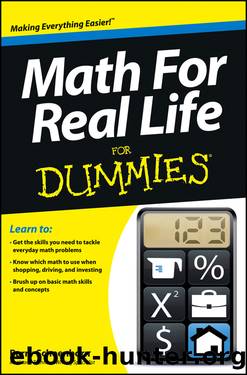Math For Real Life For Dummies by Barry Schoenborn

Author:Barry Schoenborn
Language: eng
Format: epub
Publisher: Wiley
Published: 2013-01-01T16:00:00+00:00
Chapter 8
Putting Geometry to Work at Home
In This Chapter
Calculating areas and volumes for a variety of home projects
Getting familiar with conversions so you purchase just what you need
You use math, especially geometry, around the house. All you need (for a start) is to know how to calculate the area of a rectangle (and maybe an occasional triangle or circle). I cover the general how-toâs for finding areas in Chapter 2. In this chapter, I show you how easy the math can be when you tackle some common home maintenance and improvement tasks.
Note: Although I deal with specific scenarios in this chapter â like how to find the area of a flower bed so that you know how much mulch to buy â you can use the same techniques for other tasks. After all, the same principles â and math â apply whether youâre seeding a lawn or carpeting a room.
Calculating Your Way to a Better Lawn and Garden
Taking care of the lawn, the flower beds, and the vegetable garden doesnât necessarily have to be tedious; it can be fun. Mowing the lawn was a chore when I was a kid, but the results were satisfying. And working with flower beds and a vegetable garden gives most people a lot of satisfaction.
Aside from mowing, digging, and planting, a lot of work around the home deals with spreading materials around â be they paint, concrete, or mulch. Each process takes a little math. And letâs not forget that math can also answer the question that anyone whoâs ever pushed a lawn mower on a hot summer afternoon has pondered: Just how big is this yard?
Figuring how much seed you need
A great way to improve your lawn is by over-seeding. While fertilizing is important, over-seeding is a super way to make your lawn thick and weed-free. The question is, how much seed do you need to get the lush lawn youâre striving for?
To find the answer, calculate the area of your lawn and calculate how many pounds of seed you need. For this example, assume that the lawn is a rectangle on a typical city lot.
Follow these steps:
1. Calculate the area of the front lawn.
A typical city lot width is 65 feet wide. If your house is set back 25 feet from the street, the front yardâs length is 25 feet. Now you have the numbers you need to figure area, using this formula: area = length à width.
Download
This site does not store any files on its server. We only index and link to content provided by other sites. Please contact the content providers to delete copyright contents if any and email us, we'll remove relevant links or contents immediately.
Modelling of Convective Heat and Mass Transfer in Rotating Flows by Igor V. Shevchuk(6231)
Weapons of Math Destruction by Cathy O'Neil(5853)
Factfulness: Ten Reasons We're Wrong About the World – and Why Things Are Better Than You Think by Hans Rosling(4499)
Descartes' Error by Antonio Damasio(3168)
A Mind For Numbers: How to Excel at Math and Science (Even If You Flunked Algebra) by Barbara Oakley(3109)
Factfulness_Ten Reasons We're Wrong About the World_and Why Things Are Better Than You Think by Hans Rosling(3053)
TCP IP by Todd Lammle(3019)
Applied Predictive Modeling by Max Kuhn & Kjell Johnson(2917)
Fooled by Randomness: The Hidden Role of Chance in Life and in the Markets by Nassim Nicholas Taleb(2872)
The Tyranny of Metrics by Jerry Z. Muller(2856)
The Book of Numbers by Peter Bentley(2788)
The Great Unknown by Marcus du Sautoy(2543)
Once Upon an Algorithm by Martin Erwig(2482)
Easy Algebra Step-by-Step by Sandra Luna McCune(2474)
Lady Luck by Kristen Ashley(2421)
Practical Guide To Principal Component Methods in R (Multivariate Analysis Book 2) by Alboukadel Kassambara(2386)
Police Exams Prep 2018-2019 by Kaplan Test Prep(2364)
All Things Reconsidered by Bill Thompson III(2268)
Linear Time-Invariant Systems, Behaviors and Modules by Ulrich Oberst & Martin Scheicher & Ingrid Scheicher(2239)
